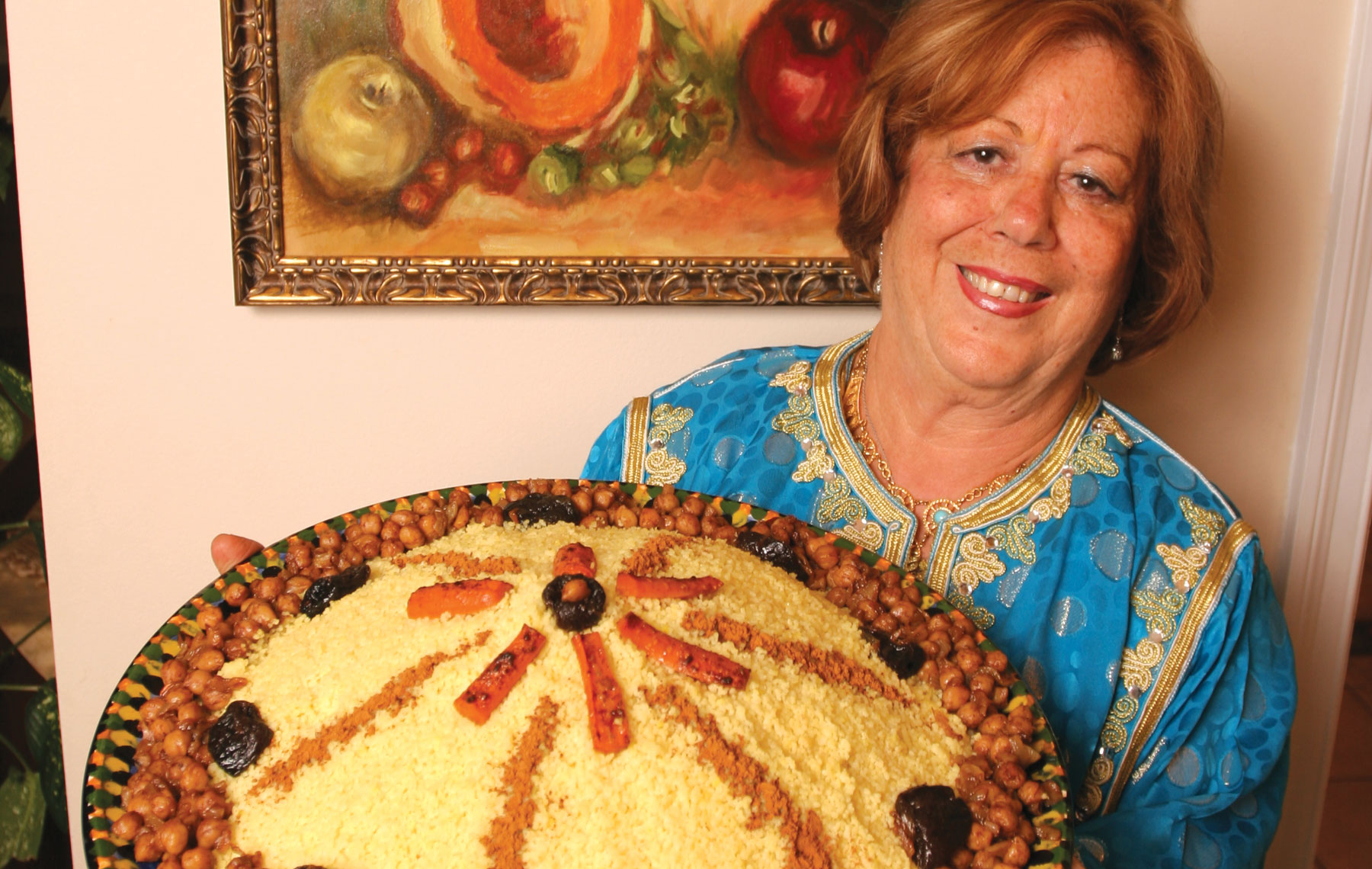
Editor’s note: Journal Food Editor Yamit Behar Wood was going to write this two-page spread. However, a family tragedy prevented her from doing that, so we reached into our archives and found these Sephardic Rosh Hashanah recipes from Mémé Suissa (Editor-in-Chief David Suissa’s mother), which were published in 2007. This section will be in honor of Yamit’s father, who died last week.
Bastilla Pastelles
1 whole small chicken*
1/4 teaspoon ground saffron, dissolved in 1/2 cup boiling water
1 tablespoon olive oil
1/2 teaspoon salt
1/2 teaspoon pepper
1 tablespoon mixed poultry herbs
2 large onions, chopped
3 tablespoons oil
1 tablespoon cinnamon
1 teaspoon sugar
6 eggs, beaten with 1 teaspoon salt added
2/3 cup fresh cilantro, finely chopped
1 cup chopped toasted almonds
10-14 sheets phyllo dough**
1 cup melted margarine, shortening or oil
Powdered sugar and cinnamon for serving and presentation
*5 cups of coarsely chopped, moist leftover chicken can substitute.
Preheat oven to 400 F.
Dilute saffron in 1/2 cup boiling water. Rub cleaned and dried chicken with olive oil and season, inside and out, with salt, pepper, herbs and 1/4 cup saffron water.
Roast, breast side down, for 45 minutes to 1 hour.
Cool slightly, strain pan juices and set aside. Remove skin and bones and cut up chicken meat into small morsels. Toss with reserved juices in a large bowl.
In a large skillet, sauté onions in oil until golden, add cinnamon and sugar and continue until browned. Add to chicken.
Combine eggs, cilantro and remaining 1/4 cup saffron water and, in the same skillet, scramble over medium heat until fluffy.
Add to chicken mixture along with toasted almonds and gently toss to combine all ingredients.
Cut rectangle phyllo sheets in half, widthwise. Place one on clean board and keep remaining sheets covered to prevent from drying.
Brush the sheet with margarine or oil. Place an additional sheet on top and brush with margarine or oil.
Place about 2-3 tablespoons filling toward the bottom, 3 inches from bottom edge. Fold left and right edges of phyllo over filling, all the way from bottom to top.
Start rolling from bottom, burrito-style, until sealed. Brush with margarine and place on baking sheet, seam side down. Continue with remaining sheets.
Bake at 350 F for 20-25 minutes until golden brown.
To serve, dust with powdered sugar and sprinkle ribbons of cinnamon.
Makes 6-8 servings
**In Morocco, we use special handmade dough, called waarka or feuille de bricke. These sheets are similar to springroll dough, except for the uneven edges, characteristic of the handmade technique of slapping a handful of soft dough, in several motions, onto the underside of a heavy skillet inverted over high heat. Each circular “leaf” is immediately peeled off and stacked as the process continues. When using this authentic dough, Bastilla Pastelles are not baked but deep-fried until golden brown, offering an exterior crunch to a delicate filling.
Lamb Tagine with Prunes and Almonds
6 tablespoons olive oil
3 pounds lamb stew, some pieces with bones
Salt, to taste
Pepper, to taste
1/2 teaspoon ground cumin
1/4 teaspoon ground saffron, diluted in 1/2 cup boiling water
1/4 cup water
3 large onions, thinly sliced
1 tablespoon cinnamon
1 teaspoon sugar
1 cup pitted prunes
1 cup dried apricots
1/2 cup golden raisins
1/2 cup broth or water
1/2 cup or more toasted slivered almonds
Heat 3 tablespoons olive oil in heavy pot and brown lamb in batches over medium-high heat. Avoid crowding the pot. Season batches with salt and pepper as you go.
Return lamb pieces to the pot. Add cumin, 1/4 cup saffron water and an additional 1/4 cup water.
Bring to a boil and immediately reduce heat. Cover and simmer for approximately 1 hour to 1 1/2 hours, until tender. Add water, 1/4 cup at a time, only if needed to maintain liquid levels at bottom of pot. Lamb will release its own juices as it cooks, so be sparse with the additional water. Don’t let the lamb become too watery.
In a large deep skillet, heat remaining 3 tablespoons olive oil. Sauté onions until golden brown.
Add cinnamon, sugar, prunes, apricots and raisins. Continue to sauté and blend. Add 1/4 cup of remaining saffron water and 1/4 cup broth or water.
Stir, cover and simmer over low heat. Add an additional 1/4 cup water as needed until dried fruits are plump and moist and have absorbed the liquids. Season with salt and pepper.
Place lamb stew and its juices in a deep and heavy earthen ovenware dish. Add fruit mixture on top.
Cover and bake at 350 F for 30 minutes.
Uncover, baste well and continue baking for an additional 15 minutes. Adjust seasonings to taste — salt, pepper, cinnamon and sugar.
To serve, plate lamb tagine on a large platter, drizzle most of its juices all over and top with roasted slivered almonds.
Makes 6-8 servings
Moroccan Fish
1 whole fish, scaled and trimmed, with head intact, 2 1/2-3 pounds*
1/4 cup olive oil
1/4 cup fresh Italian parsley, chopped
1/4 cup fresh cilantro, chopped
3 garlic cloves, crushed
2 teaspoons paprika
1/4/-1/2 teaspoon cayenne pepper, to taste**
juice of 1/2 lemon
1/8 teaspoon ground saffron, dissolved in 1/4 cup boiling water
Salt, to taste
Pepper, to taste
3 tablespoons olive oil
5 carrots, peeled, cut into sticks
2 red bell peppers, cut into 8 pieces
3 garlic cloves, halved
2 teaspoons paprika
Salt, to taste
Pepper, to taste
Fresh cilantro, chopped
1 lemon, thinly sliced
* Fillets of any fish may be substituted at other times of the year.
Wash fish and pat dry with paper towels. Mix next 10 ingredients to make a paste. Coat fish thoroughly with savory paste, inside and out. Cover and refrigerate up to 1 hour.
In a large skillet, heat 3 tablespoons oil over medium/high heat. Add carrots, peppers and garlic and sauté for 3-4 minutes.
Reduce heat, cover and cook an additional 8-10 minutes until vegetables are tender but firm.
Add paprika, salt, pepper and 2 tablespoons water and stir well. Place vegetables and scrape all paprika, oil and liquid into an oblong baking dish (length of fish).
Place fish and marinade on top of vegetables. Arrange lemon slices and sprinkle with chopped cilantro. Cover and bake at 375 F for 20-25 minutes until fish is flaky and moist, basting occasionally.
**Moroccan Fish is always spicy hot to some degree, except when served on Rosh Hashanah, when we refrain from serving spicy foods and enjoy only the sweetness of the holiday meals.
Makes 6-8 servings
Squash Pumpkin Soup
3 tablespoons oil
3 large onions, thinly sliced
1/2 pound soup meat with bones
Salt, to taste
Pepper, to taste
10-12 cups water
8 cups very orange squash (butternut, banana, pumpkin or combination), cut up
1 15-ounce can garbanzo beans, drained and rinsed
2 teaspoons cinnamon (or more to taste)
2 teaspoons sugar
1/8 teaspoon ground saffron, dissolved in 1/4 cup boiling water
In a large pot, heat oil and add sliced onions. Sauté on medium/high heat until golden.
Add meat, season with salt and pepper, and continue to sauté until meat and onions brown well.
Add 10 cups water and bring to a boil. Reduce heat and simmer meat for 20 minutes.
Add cut-up squash. Cook until squash is thoroughly cooked and soft, approximately 30-45 minutes.
Remove meat onto a plate. Discard bones and cut meat into small morsels. Set aside.
Mash soup with a potato masher or large fork until smooth, adding more water if soup is too thick.
Add meat morsels, garbanzo beans, cinnamon, sugar and saffron water. Combine well and simmer for an additional 20-30 minutes, stirring frequently.
Adjust salt and pepper seasonings before serving.
Makes 8-10 servings
Meme’s Classic Cous Cous
Meme’s classic couscous presentation, customarily served on Rosh Hashanah and Sukkot: A handsome heap of fluffy couscous surrounded by a sweet mixture of caramelized onions, raisins and garbanzo beans (recipe follows), decorated with slivered almonds, ribbons of cinnamon, cooked carrot strips, and a dusting of powdered sugar.
Traditionally, couscous is steamed in a couscousier, a tall pot with a tight-fitting steamer above it, in which the rinsed couscous is delicately placed and steamed twice. This method produces a fluffy and light couscous, with no trace of starch.
The process is as follows:
Place the content of one box of couscous in a large bowl. Rinse with water and drain well. Drizzle with oil and sprinkle with salt and, with your fingers, work the couscous to loosen and open all the small granules. Let stand until the moisture is absorbed. Separate the granules once again and place the couscous in the steamer over the pot filled with a good broth (you may add orange root vegetables, onions and cabbage to this and also serve as a side). Steam for about 15 minutes. Remove the couscous to a bowl and let cool slightly. Loosen the granules and add 1/4 cup of any tasty broth (chicken or vegetable) or the broth in the pot, ideally with added saffron. Stir well. When completely absorbed, return the couscous to the steamer and steam once again for about 20 minutes. Add an additional 1/4 cup or more of broth, fluff with fork and keep covered until ready to serve.
Note: Alternatively, you may prepare the couscous as directed on the box, using a good broth (with added saffron) instead of the water.
Chop 2 onions and brown well (caramelize) in 3 tablespoons of oil. Add 1 cup of golden raisins and continue cooking on medium heat, adding 2 tablespoons of water at a time as needed to soften and plum raisins. Add one can of drained, rinsed and peeled garbanzo beans, 1/4 cup chicken or tasty broth, 3 tablespoons of honey (or more to taste), a teaspoon of cinnamon, salt and pepper. Simmer for about 15-20 minutes, adding additional liquid to retain moisture.
To serve:
Heap fluffed couscous onto a large round platter and form into a point using a large spoon in an upward motion. Surround the base of the couscous with the garbanzo/raisin mixture. Decorate with ribbons of cinnamon, cooked carrot strips and almonds, and finish with a dusting of powdered sugar.
-Kathy Shapiro






















 More news and opinions than at a Shabbat dinner, right in your inbox.
More news and opinions than at a Shabbat dinner, right in your inbox.